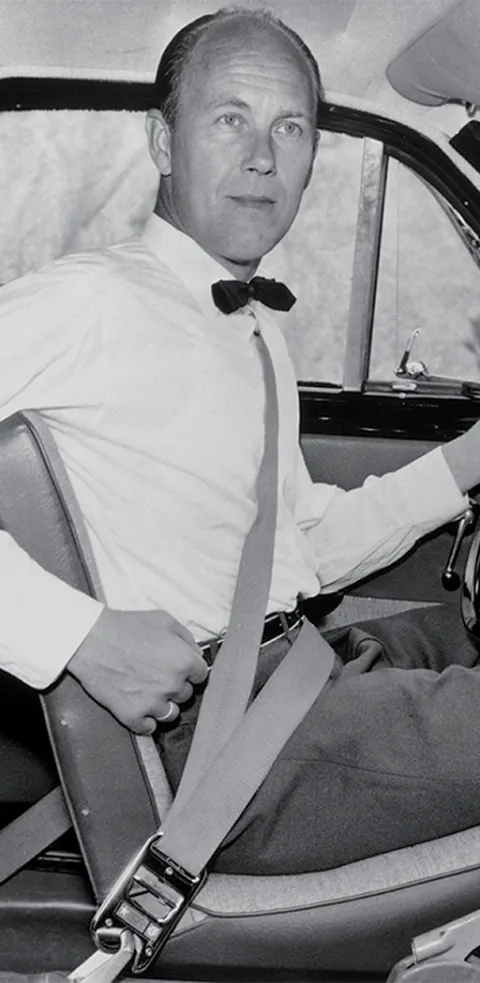
HISTORY
Fifty years ago the world was very different, cars had no seat belts. But the hour had come for a small Swedish ribbon weaving company.
Today it is hard to imagine that a few decades ago, most cars were shipped without seat belts. In other respects, too little attention was paid to accident prevention at that time and so many collisions, from which today one would emerge unscathed, had fatal consequences.
In order to counter this, the Swedish car company Volvo approached the ribbon weaving companies AB Textilkonst and Klippan at the end of the 1950s, with instructions to develop a safety belt for its vehicles.
Volvo was already building very sturdy cars that withstood the harsh Swedish winters and other tests, but it wanted to continue to improve the safety of the occupants.
Together with Volvo engineers, Klippan developed the first car safety belt in the world, made of high-strength fabric ribbon. It was installed in models Amazon and 544 for the first time in 1959 and caused a lot of astonishment in the public, but also ensured an enduring image of Swedish inventions as both pioneering and durable.
How We Replaced Ropes and Chains
The car safety belt was a great success, and soon other manufacturers had also installed it. Thanks to the great demand, Erik Ehnimb, co-owner of Klippan, was able to found the SpanSet company in Malmö in 1966.
The ribbons produced by SpanSet were quickly and enthusiastically employed in many other areas, where up to that point chains and wire ropes had been used, as in the case of the transport of paper. The customers appreciated the enormous load-bearing capacity of the new lashing and lifting belts.
In 1967, Mr. Ehnimb founded SpanSet AG in Hombrechtikon in the Zurich highlands, and additional companies in Germany, Italy, France and England. Later, companies in Asia, America and Australia were added, thus forming a global distribution network.
SpanSet continues to live up to their international heritage of innovations in design with new developments in products and services. The new developments enable us to push beyond the basic European Standards for design in Height Safety equipment.
How Our Inventions Became the Norm...
The SpanSet products with their load capacity have gained such a good reputation around the world that interntional safety standards have been orientated to it.
The development of standards for lifting equipment has been significantly influenced by SpanSet; for instance, in national working groups that determine what constitutes a standard and in which SpanSet is regularly included.
This is how something becomes the norm: by setting a standard. And doing so repeatedly for more than 40 years.
...And Our Norm Influenced New Inventions
This also means that we are often called on during the development of a new product (after all, it will eventually be transported by our belts) and also increasingly offer support as a partner for safety training and consultation. This is how SpanSet went from small ribbon weaving company to international forerunner when it comes to transportation and safety – through exceptional performance and recognition.
How We Let One World First Follow the Next
In 1987, SpanSet launched the “Power” sling series as well as the new generation of roundslings with textile wire reinforcement in the protective jacket for maximum tear resistance – even back then capable of bearing up to 50 tons.
In 1992, the Horizontal Safety Line – the first temporary horizontal anchorage line to employ a webbing and ratchet system for pretension, and to give a predictable deflection during a fall.
The ABS pressure ratchet, another world first, appeared in 1995. This allows a gradual release of the tensioned ratchet, so that goods at risk of falling could be unloaded safely.
2001, The Gotcha range of rescue equipment. The first pre-assembled rescue kits offering remote attachment and recovery of a suspended worker. Followed by the WRAPPA, the first anchorage sling tested for attachment to a vertical tube on a scaffold structure.
In 2002, SpanSet launched the Tension Force Indicator (TFI) which is integrated in the tensioning ratchet and indicates the pre-tensioning force. Thus, the use of lashing equipment became safer and more economical. The TFI is now incorporated into the Horizontal Safety Line above.
SpanSet – A Way to Success That Always Results From Being One Step Ahead!
We are quite proud of our achievements. After all, they have contributed to safer and easier working conditions around the world – and thus to fewer accidents and lower operating costs.
We were especially glad to hear the story of a policeman, who during a truck check replaced his official severity with a friendly smile after seeing that the cargo was secured with our products.
Meeting Standards Is Good. Setting Standards Is Better.
The SpanSet brand stands for something. Not only for meeting international safety standards, but for raising them again and again. For example, the new EU lashing standard would not exist without our lashing belts.
This is exactly what we stand for with our products, services and consultancy: for more security than is demanded today – namely, as much as is possible tomorrow.
That is our goal, that is our job and that is our passion. So that those who work with SpanSet can also trust in it in the future – just like the police.